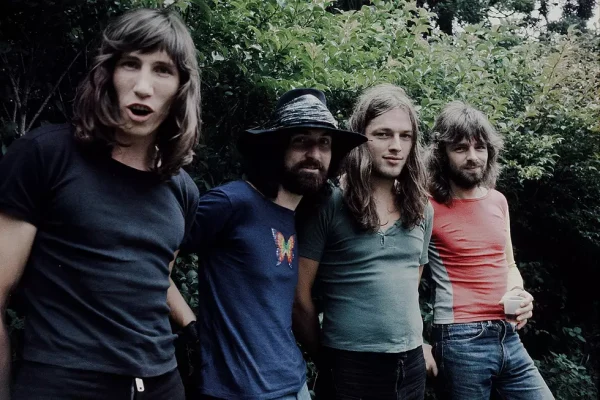Pink Floyd Unreleased Music: Gilmour Reveals Surprise Approach
When did Pink Floyd start sharing unreleased music with fans? The answer might surprise you! David Gilmour just dropped some fascinating insights about how these legendary classic rock artists have been delighting audiences with brand-new material long before hitting the studio to officially record it.
Picture this: it’s June 1974, and you’re standing in a packed venue watching Pink Floyd unleash their newly upgraded production, complete with that iconic circular video screen. But here’s where it gets wild – just a year after “The Dark Side of the Moon” conquered the world, the band’s already road-testing completely fresh material that won’t see official release for another year or more!


How Pink Floyd Shared Unreleased Music Before Album Releases
In a revealing new interview, Gilmour explained how Pink Floyd unreleased music became a regular feature of their live shows during the mid-1970s. The band premiered an early version of “Shine on You Crazy Diamond” from the upcoming “Wish You Were Here” album, along with works-in-progress like “Raving and Drooling” (which evolved into “Sheep”) and “You’ve Got to Be Crazy” (later transformed into “Dogs”). These tracks wouldn’t appear on the “Animals” album until 1977 – years after fans first heard them live!
“Those songs came together in a tiny rehearsal room,” Gilmour recalls in his conversation with Ultimate Classic Rock. He revealed that Roger Waters wanted to split “Shine on You Crazy Diamond” into two parts, making it the centerpiece of their next album. “I was really slightly unwilling at the beginning, but you know, these things are commonplace, these little arguments. But he was right, and we carried on with that.”
Why Did Pink Floyd Preview Their Unreleased Music?
What drove this approach to sharing Pink Floyd unreleased music? The practice allowed the band to refine their compositions through live performance, using audience reactions to shape the final studio versions. This organic evolution process became a hallmark of their creative method during their most productive era.
Gilmour continues this tradition today, treating Pink Floyd unreleased music as a living, breathing entity. The 2007 “Barn Jam” featuring his touring band and longtime Pink Floyd bandmate Richard Wright kept generating new material nearly two decades later. That unconventional session helped form the skeleton of the title track for his 2024 “Luck and Strange” album.
David Gilmour’s Magpie Approach to Music
“I store everything like a magpie – I store it away somewhere and forget about it,” Gilmour admits. “Sometimes I’m playing through old files and I find something that I haven’t heard for years. These things always have a way of sparking you off and thinking again about something that you may not have quite managed to get finished yet.”
This philosophy explains why Pink Floyd unreleased music continues surfacing even decades after original recording sessions. The band’s vault contains numerous gems from various eras, including material from their Syd Barrett days and experimental sessions that never made it to official albums.
What Unreleased Pink Floyd Material Exists?
Beyond the live previews, Pink Floyd unreleased music encompasses a fascinating range of material. From early Barrett-era recordings like “I Get Stoned” and “Lucy Leave” to experimental projects like “Household Objects” (which used everyday items as instruments), the band’s archived material showcases their creative evolution.
The 2016 box set “The Early Years 1965-1972” and 2019’s “The Later Years” officially released several previously unreleased tracks, giving fans access to rare recordings that had circulated on bootlegs for years. This classic rock news thrilled collectors who’d spent decades hunting down unofficial recordings.
Celebrating the Legacy: New Releases Coming
Gilmour recently wrapped up his “Luck and Strange” tour, performing at historic venues including Rome’s Circus Maximus, London’s Royal Albert Hall, and Madison Square Garden. The tour celebrates his first album of new material in nine years, and it’s being commemorated with “The Luck and Strange Concerts” live album and “Live at the Circus Maximus” concert film, both releasing October 17, 2025.
The setlist beautifully blended Pink Floyd classics with solo material, including a touching rendition of “Between Two Points” featuring his daughter Romany Gilmour. While some fans hoped for more 1970s Floyd material, Gilmour explained his desire to showcase his entire catalog rather than simply being a Pink Floyd tribute act.
Why Pink Floyd Unreleased Music Still Matters
The practice of debuting Pink Floyd unreleased music live represented something revolutionary in classic rock. Most bands kept new material under wraps until official release, but Floyd trusted their audience with works-in-progress. This approach created a deeper connection between band and fans, making concert-goers feel like participants in the creative process rather than passive consumers.
As Gilmour demonstrated with material from the “Barn Jam” eventually appearing on “Luck and Strange,” great songs don’t always arrive on schedule. Sometimes they need years to mature, waiting for the right moment and the right collaborators. That patience and willingness to revisit old ideas separates true artists from mere hit-makers.
For fans wondering what makes Pink Floyd unreleased music so special, it’s this willingness to experiment, evolve, and trust the creative process. From “See Emily Play” to “Shine on You Crazy Diamond,” the band’s greatest works often emerged from extensive live development and refinement.
What’s Next for David Gilmour?
Following the “Luck and Strange” tour, Gilmour hinted at recording another album with his current band. At 78, he shows no signs of slowing down, continuing to push musical boundaries while honoring the legacy of Pink Floyd. Whether more Pink Floyd unreleased music surfaces from the vaults or new compositions emerge from his ongoing collaborations, fans can expect Gilmour to maintain his uncompromising artistic standards.
The story of Pink Floyd unreleased music reminds us why this band remains culturally significant decades after their commercial peak. They treated music as art rather than product, prioritizing creative integrity over market demands. That approach yielded some of the most enduring albums in rock history – and promises more discoveries await in those carefully preserved archives.
Affiliate Disclosure: This article may contain affiliate links. If you make a purchase through these links, I may earn a small commission at no additional cost to you. This helps support the site and allows me to continue providing classic rock content. Thank you for your support!

